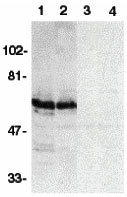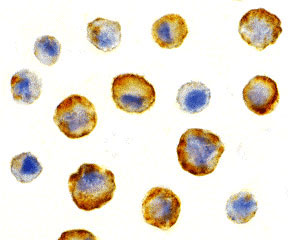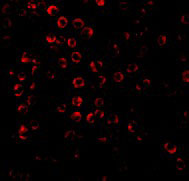SODD Antibody
- SPECIFICATION
- CITATIONS
- PROTOCOLS
- BACKGROUND

Application
| WB, IF, ICC, E |
|---|---|
| Primary Accession | O95429 |
| Other Accession | AF111116, 4160013 |
| Reactivity | Human, Mouse, Rat |
| Host | Rabbit |
| Clonality | Polyclonal |
| Isotype | IgG |
| Calculated MW | 60 kDa |
| Application Notes | SODD antibody can be used for detection of SODD by Western blot at 0.5 µg/mL. An approximately 60 kDa band can be detected. Antibody can also be used for immunocytochemistry starting at 5 µg/mL. For immunofluorescence start at 20 µg/mL. |
| Gene ID | 9530 |
|---|---|
| Other Names | SODD Antibody: SODD, BAG-4, SODD, BAG family molecular chaperone regulator 4, Bcl-2-associated athanogene 4, BCL2-associated athanogene 4 |
| Target/Specificity | BAG4; |
| Reconstitution & Storage | SODD antibody can be stored at 4℃ for three months and -20℃, stable for up to one year. As with all antibodies care should be taken to avoid repeated freeze thaw cycles. Antibodies should not be exposed to prolonged high temperatures. |
| Precautions | SODD Antibody is for research use only and not for use in diagnostic or therapeutic procedures. |
| Name | BAG4 |
|---|---|
| Synonyms | SODD |
| Function | Inhibits the chaperone activity of HSP70/HSC70 by promoting substrate release (By similarity). Prevents constitutive TNFRSF1A signaling. Negative regulator of PRKN translocation to damaged mitochondria. |
| Cellular Location | Cytoplasm. |
| Tissue Location | Ubiquitous. |

Thousands of laboratories across the world have published research that depended on the performance of antibodies from Abcepta to advance their research. Check out links to articles that cite our products in major peer-reviewed journals, organized by research category.
info@abcepta.com, and receive a free "I Love Antibodies" mug.
Provided below are standard protocols that you may find useful for product applications.
Background
SODD Antibody: Apoptosis is induced by certain cytokines including TNF and Fas ligand of the TNF family through their death domain containing receptors, TNF-R1 and Fas. Several novel death receptors including DR3, DR4, DR5, and DR6 were recently identified. Cell death signal is transduced by death domain containing adapter molecules through the interaction with death domain of these death receptors. A novel TNF-R1 interacting protein was recently identified and designated SODD for silencer of death domains. SODD associates with the death domain of TNF-R1 and prevents constitutive activation of TNF-R1 signaling. TNF treatment releases SODD and permits adapter molecules such as TRADD recruiting to the active TNF-R1 complex, which activates TNF signaling pathways. SODD also interacts with DR3. SODD is ubiquitously expressed in human tissues and cell lines.
References
Jiang Y, Woronicz JD, Liu W, Goeddel DY. Prevention of constitutive TNF receptor 1 signaling by silencer of death domains. Science 1999;283:543-6 (RD1299)
If you have used an Abcepta product and would like to share how it has performed, please click on the "Submit Review" button and provide the requested information. Our staff will examine and post your review and contact you if needed.
If you have any additional inquiries please email technical services at tech@abcepta.com.













 Foundational characteristics of cancer include proliferation, angiogenesis, migration, evasion of apoptosis, and cellular immortality. Find key markers for these cellular processes and antibodies to detect them.
Foundational characteristics of cancer include proliferation, angiogenesis, migration, evasion of apoptosis, and cellular immortality. Find key markers for these cellular processes and antibodies to detect them. The SUMOplot™ Analysis Program predicts and scores sumoylation sites in your protein. SUMOylation is a post-translational modification involved in various cellular processes, such as nuclear-cytosolic transport, transcriptional regulation, apoptosis, protein stability, response to stress, and progression through the cell cycle.
The SUMOplot™ Analysis Program predicts and scores sumoylation sites in your protein. SUMOylation is a post-translational modification involved in various cellular processes, such as nuclear-cytosolic transport, transcriptional regulation, apoptosis, protein stability, response to stress, and progression through the cell cycle. The Autophagy Receptor Motif Plotter predicts and scores autophagy receptor binding sites in your protein. Identifying proteins connected to this pathway is critical to understanding the role of autophagy in physiological as well as pathological processes such as development, differentiation, neurodegenerative diseases, stress, infection, and cancer.
The Autophagy Receptor Motif Plotter predicts and scores autophagy receptor binding sites in your protein. Identifying proteins connected to this pathway is critical to understanding the role of autophagy in physiological as well as pathological processes such as development, differentiation, neurodegenerative diseases, stress, infection, and cancer.




